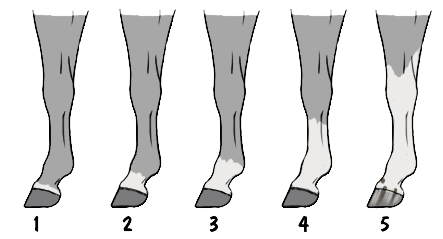Body markings
The Drabardi donkey has two main categories of white pattering; spotted and roan. There are two varieties of spotted and three of roan, plus one special 'combination pattern' caused by an interaction between spotted + roan.
| # Spotted | # Roan | # Facial markings | # Leg markings |
Leg markingsHere you will see descriptions and diagrams of the white leg markings and their ranges that a Drabardi can have. Unless the Drabardi has the spotted gene the leg markings are usually very small, very seldom reaching over the fetlock. Along with big facial markings, leg white that reaches just below or over the knee and hock is usually an indicator of a spotted donkey.  | [N] Normal | [S] Spotted gene |
| [N] Normal | [S] Spotted gene |0) No Markings (Not pictured) - "No markings" - Most Drabardi donkeys don't have any leg markings unless they are spotted. 1) Coronet [N] - White just above the hoof, around the coronet. Common normal marking. If the white is located only at the back, it is called a "white heel". 2) Half pastern [N] - Common normal marking. Extends above the top of the hoof, but stops below the fetlock. 3) Fetlock [N] - Uncommon normal marking. Extends a little over the fetlock. 4) Sock [S] - Only for donkeys with the spotted gene. Extends higher than the fetlock but not past the knee or hock. 5) Stocking [S] - Only for donkeys with the spotted gene. Extends at least to the bottom of the knee or hock, sometimes higher. Ermine spot (shown on [5]) - A splotch of black in an otherwise white marking on the face or legs. They can be of any size or shape and can occur on all donkeys. |

|
The group is flexible when it comes to the looks of the markings (since nature doesn't always follow the rules and goes by *strict* lines), so as long as your markings are similar to the examples you shouldn't have any issues. As long as the marking is still visually identifiable everything is good in the hood. NOTE - if too many people abuse this, rules will become stricter.